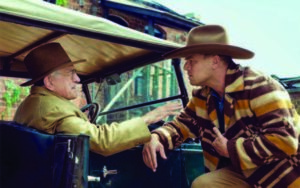Movie Review: Killers of the Flower Moon
By Dwight Brown, NNPA Film Critic / October 27, 2023
Robert DeNiro and Leonardo Dicaprio star in Killers of the Flower Moon. A movie about members of the Osage tribe being murdered in mysterious and sometimes brutal ways.
Why in the 21st century is anyone making a film about the Native American experience from a White man’s perspective? What is there to gain? Just great artistry that overshadows indigenous people.
Author David Grann based his novel Killers of the Flower Moon on information he gathered from FBI reports and archival materials. His mix of fact and fiction centers around the Osage “Reign of Terror” in early 1920s Oklahoma. A tragedy that happened around the time of the Tulsa race massacre of 1921, when White racists, envious of Black wealth, terrorized and burned down neighborhoods. Similarly, Osage tribe members have become rich from the oil on their lands. Thirty million dollars ($400M in today’s money) comes their way, making them the wealthiest people per capita in the world. The mineral rights to their reservation are put in a federally managed trust, they receive royalties doled out by guardians. White men pray on them, marrying their women for their wealth. Scoundrels to the left. Scoundrels to the right.
The gold digging is heinous, the charlatans devious. Even worse, some truly sociopathic types marry and murder tribal members for financial gain. This is that story. Not largely told from the standpoint of the Native Americans themselves, but from that of the perpetrators. The novel highlights the government’s investigation. Now this film veers away from the Osage too, making them supporting characters in their own story.
A long-winded initial scene sets up the film’s two main characters. Ernest Burkhart (Leonardo DiCaprio) is poor as a church mouse when he reconnects with this uncle, William “King” Hale (Robert DeNiro). That rich cattle rancher is a local kingpin in the town of Fairfax, in the county of Osage, Oklahoma. Ernest becomes a car service driver to make money and one day he picks up a beautiful and rich Native American woman, Mollie (Lily Gladstone, Fancy Dance). The two flirt. She’s cautious at first. Pity she wasn’t more vigilant, because when she opens the door to the henhouse, the fox comes in for the kill. Mollie: “Coyote likes money.”
Members of the Osage tribe are being murdered in mysterious and sometimes brutal ways. Tribunals gather and assess the problems. Says Paul Red Eagle (Everett Walker): “When this money start comin,’ we shoulda known it came with something else.” Local law enforcement is inept, only carrying the bodies away. Mollie’s family members start to meet the same fate, and she’s nervous for the ones that are still alive. She should be, the killers lurk close. King acts concerned and pretends to be a friend of the Osage people. He knows more than he’s saying. There’s no blood on his hands. Hard to trace anything back to him. When will people get wise?
Rarely in a good murder mystery does the storyline peg the killers right from the jump. This adaptation, written by Eric Roth (Dune) and director Martin Scorsese, does. Viewers watch the scheming and slayings from the eyes of the culprits. Yes, there are scenes with Mollie and other Osage members showing their concern, going to the authorities for help and even to Washington D.C. But too much of what’s on view does not involve them, the protagonists, solving their own problem, which is a standard rule in good screenwriting. This is a dubious creative choice at best. A gamble.
As audiences watch the gruesome killings they’ll wonder, when will this stop? When will the Osagers grab a gun and kill the perpetrators who decimate their people? Will they have satisfaction? Watching killing after killing becomes repulsive then macabre. Finally, when the calvary shows up, it’s the White saviors. Bureau of Investigation (BOI) Agent Tom White (Jesse Plemons, The Power of the Dog) is sent by J. Edgar Hoover on what will be the bureau’s first major homicide investigation. Tom: “I was, uh, sent down from Washington D.C., to see about these murders.” Ernest: “See what about ‘em.” Tom: “See who’s doin’ it.”
Within the confines of the script’s follow-the-devils structure, Scorsese proves that he is still a master storyteller—in the epic feature film format. Though, many viewers, whose butts will grow numb from sitting for 3h 26 m, may wish his expertise was with mini-series or series, more appropriate formats. Regardless, the visuals are stunning. The director and cinematographer Rodrigo Prieto (The Irishman) are artists. The angles, composition, interior and exterior lighting, and saturated colors are visually stunning. Scorsese is particularly adept at the movement within crowd scenes, from the extras to the leads. He gives the entire cast, top to bottom, room to emote, exchange thoughts and express feelings from fear to rage.
The technical aspects fluctuate down and up. Jack Fisk’s (The Revenant) production design is too perfect. Jacqueline West’s (The Revenant)) costumes should have been rougher around the edges. Editor Thelma Schoonmaker (The Irishman) needed a heavier hand and should have cut 20 minutes from the footage—or more. On the other hand, Robbie Robertson’s (The Irishman) musical soundtrack is incredibly atmospheric. His music alternates between a funky, drum-heavy Native American beat, chants and evocative songscapes. To hear more of his indigenous-themed music, listen to Robertson’s groundbreaking 1994 album Music for Native Americans, which drew from his Mohawk heritage.
Any film that pairs DeNiro and DiCaprio is a gem. DeNiro shines and sneers well, but sometimes it feels like he’s interjecting 21st century urban sensibilities into the King character. DiCaprio is invisible, deep inside the increasingly culpable and murderous Ernest. As he walks through a crowd on Fairfax’s main dirt road the actor grabs the camera’s attention. The way he walks, wears his cowboy hat, makes facial expressions and his mannerisms steal the scenes from the hundreds of extras. He’s totally believable as a 1920s man and as earthy as any Steinbeck character. He’s magnetic.
Gladstone’s presence is felt even in the scenes she isn’t in. Her Mollie is the sane voice among the debauchery and criminal conspiracy. A low-key, strong-willed woman destined to find help when no one else can. Pity her character is rendered so helpless for so long. Pity when she finally confronts the person who’s tortured her there’s no anger. No slap. No wishing him dead for what he’s done. It makes you wonder if a woman, specifically a Native American one, had written the script would she have allowed Mollie, or the Osage Nation members, to look so passive?
If you’re looking for a good glimpse into the world of Native Americans, from their perspective, check out Lakota Nation vs United States, an enlightening documentary that’s streaming on Prime Video and Apple TV+.
Watching Killers of the Flower Moon to learn anything about the viewpoints of Native Americans may be a frustrating experience. Watching the movie for its magnificent artistry may not. It’s an opulent, indulgent crime/drama/history film made from bits of facts and padded with fiction. Nothing more.
Score: 3 stars.
Visit NNPA News Wire Film Critic Dwight Brown at BlackPressUSA.com.







